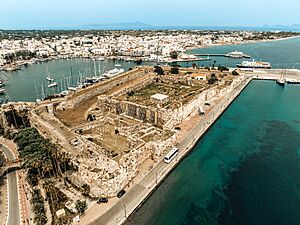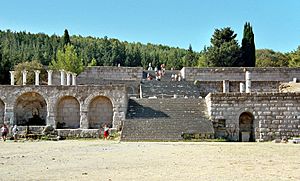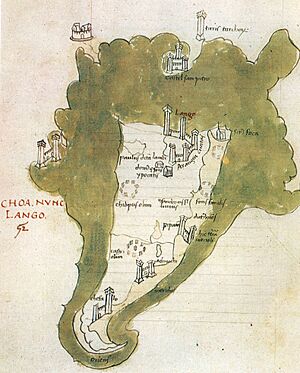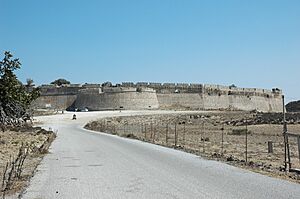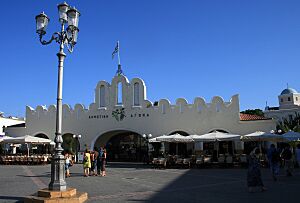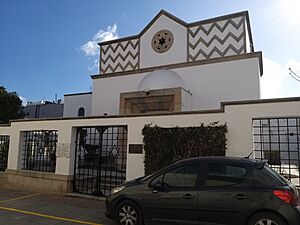Kos facts for kids
Quick facts for kids
Kos
Κως
|
|
|---|---|
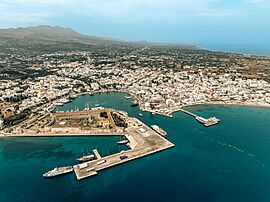
Aerial view of Kos town
|
|
| Country | Greece |
| Administrative region | South Aegean |
| Regional unit | Kos |
| Area | |
| • Municipality | 295.3 km2 (114.0 sq mi) |
| • Municipal unit | 67.2 km2 (25.9 sq mi) |
| Highest elevation | 843 m (2,766 ft) |
| Lowest elevation | 0 m (0 ft) |
| Population
(2021)
|
|
| • Municipality | 37,089 |
| • Municipality density | 125.598/km2 (325.30/sq mi) |
| • Municipal unit | 21,430 |
| • Municipal unit density | 318.90/km2 (825.9/sq mi) |
| Demonym(s) | Koan, Coan |
| Time zone | UTC+2 (EET) |
| • Summer (DST) | UTC+3 (EEST) |
| Postal code |
853 xx
|
| Area code(s) | 2242 |
| Vehicle registration | ΚΧ, EA |
| Website | www.kos.gr |
Kos (pronounced like "coss") is a beautiful Greek island. It is part of the Dodecanese island group in the southeastern Aegean Sea. Kos is the third largest island in this group, after Rhodes and Karpathos. About 37,089 people live there (2021 census), making it the second most populated Dodecanese island after Rhodes. The island is about 42 kilometers (26 miles) long and 11.5 kilometers (7 miles) wide. Kos is a municipality within the Kos regional unit, which is part of the South Aegean region. The main town and center of the island is also called Kos.
Contents
- What's in a Name? The History of Kos's Names
- Exploring the Geography of Kos
- Understanding Kos's Climate
- How Kos is Governed: The Municipality
- Economy: How People Make a Living on Kos
- A Journey Through Kos's Rich History
- Understanding Kos's Geology
- Who Lives on Kos? Demographics and Culture
- Main Sights: What to See on Kos
- Culture and Famous People of Kos
- Getting Around: Transport on Kos
- Images for kids
- See also
What's in a Name? The History of Kos's Names
The name Kos (Κῶς) has been used for a very long time. It first appeared in an ancient Greek poem called the Iliad. In the past, Kos was also known by other names like Meropis, Cea, and Nymphaea.
How Did "Stancho" and "Lango" Come About?
In some old languages, Kos was called Stancho or Stanchio. In Ottoman and modern Turkish, it is known as İstanköy. These names came from a Greek phrase, εις την Κω, which means 'to Kos'. It's similar to how the name Istanbul came to be! When the Knights Hospitaller from Rhodes ruled the island, they called it Lango or Langò. This name probably came from the island's long shape. If you are from Kos, you are called a "Koan."
Exploring the Geography of Kos
Kos is located in the Aegean Sea, very close to Bodrum, Turkey. Its coastline stretches for about 112 kilometers (70 miles).
Main Towns and Villages on Kos
The main town and port is Kos Town. Other important villages on the island include Kardamena, Kefalos, Tingaki, Antimachia, Mastihari, Marmari, and Pyli. Smaller villages are Zia, Zipari, Platani, Lagoudi, and Asfendiou.
Understanding Kos's Climate
Kos has a hot-summer Mediterranean climate. This means it has hot, dry summers and mild, wet winters.
| Climate data for Kos Sewage Plant weather station (37m) | |||||||||||||
|---|---|---|---|---|---|---|---|---|---|---|---|---|---|
| Month | Jan | Feb | Mar | Apr | May | Jun | Jul | Aug | Sep | Oct | Nov | Dec | Year |
| Mean daily maximum °C (°F) | 14.3 (57.7) |
15.5 (59.9) |
17.6 (63.7) |
20 (68) |
25 (77) |
28.5 (83.3) |
30.4 (86.7) |
31 (88) |
28.5 (83.3) |
25.7 (78.3) |
21.1 (70.0) |
17.4 (63.3) |
22.9 (73.3) |
| Mean daily minimum °C (°F) | 9 (48) |
10.1 (50.2) |
11.2 (52.2) |
12.9 (55.2) |
16.8 (62.2) |
20.9 (69.6) |
23.5 (74.3) |
24 (75) |
22.2 (72.0) |
19.6 (67.3) |
15.6 (60.1) |
12.3 (54.1) |
16.5 (61.7) |
| Average precipitation mm (inches) | 214.7 (8.45) |
82.3 (3.24) |
68.2 (2.69) |
40.6 (1.60) |
7.2 (0.28) |
13.8 (0.54) |
0 (0) |
0 (0) |
5.2 (0.20) |
36.3 (1.43) |
106 (4.2) |
175.6 (6.91) |
749.9 (29.54) |
| Source: http://penteli.meteo.gr/stations/kos/ (2019 - 2020 averages) | |||||||||||||
How Kos is Governed: The Municipality
The current municipality of Kos was formed in 2011. It combined three smaller areas:
- Dikaios
- Irakleides
- Kos
The municipality covers an area of about 290 square kilometers (112 square miles).
Economy: How People Make a Living on Kos
Tourism is the most important industry on Kos. People love the island's beautiful beaches! Kos Town, the main port, is a popular spot for tourists. It has many hotels, restaurants, and nightclubs. The village of Kardamena is also a favorite place for young holidaymakers, especially from the United Kingdom and Scandinavia.
Growth in Luxury Tourism
In recent years, many new luxury hotels have been built on Kos. The number of five-star hotels has almost doubled since 2014. This shows that more people are looking for fancy places to stay on the island.
Farming and Famous Crops
Farming is the second most important job on Kos. Farmers grow crops like grapes, almonds, figs, watermelons, olives, and tomatoes. They also grow wheat and corn. Did you know that Cos lettuce (also known as romaine lettuce) is named after the island? It's believed to have come from here!
A Journey Through Kos's Rich History
Mythological Beginnings of Kos
In ancient Greek stories, Kos has a special place. In Homer's famous poem, the Iliad, people from Kos fought alongside the Greeks in the Trojan War. Some myths say that Merops was the first king of Kos. The island was also visited by the hero Heracles. It was even believed to be the birthplace of the goddess Leto, who was the mother of Apollo.
Ancient Times: From Dorians to Persians
Around the 11th century BC, a group called the Dorians came to Kos. They started a colony and brought their special worship of Asclepius, the god of healing. This made Kos famous for its healing centers. Later, in the 6th century BC, Kos was controlled by the Achaemenid (Persian) Empire. But after a Greek victory in 479 BC, Kos rebelled and became free.
Classical Era: A Time of Change and Silk
During the Greco-Persian Wars, Kos was sometimes ruled by Persian leaders. But usually, it had an oligarchic government, meaning a few powerful people ruled. In the 5th century BC, Kos joined the Delian League, a group of Greek city-states led by Athens. In 366 BC, a new democratic government was set up. The capital moved from Astypalaea to the newly built Kos town.
Kos was also known for its silk. People on the island made beautiful, light silk clothes. Some ancient writers believed these clothes were called Coae vestes.
Hellenistic Era: A Center of Learning and Trade
During the Hellenistic period, Kos became very rich and important. The Egyptian rulers, the Ptolemies, valued Kos as a naval base. It also became a famous place for learning, like a branch of the great library in Alexandria. Many important scholars and poets lived here. There was also a medical school on Kos.
Kos was known for its fairness. Many other cities asked Kos to send judges to help solve their disagreements. This shows how much people trusted the island's sense of justice. Kos also produced silk, oars, and large clay jars called amphorae. Many new buildings were constructed, including a theater and a market.
Roman Era: Peace and Progress
Under Roman rule, Kos was mostly peaceful, except for a few pirate attacks and earthquakes. In 53 AD, it became a "free city," meaning it had some independence. Kos continued to be a center for learning. A library was built, and famous people like Hippocrates (the "father of medicine") were from the area.
Byzantine Era: A Long Period of History
Kos was part of the Byzantine Empire for many centuries. Its bishops attended important church meetings. The island was governed by different officials and became more important in the 11th and 12th centuries.
Genoese and Ottoman Rule
After the 11th century, Kos came under the control of the Republic of Genoa. Later, in the 14th century, the Knights Hospitaller (a military and religious order) took over the island. They built strong castles to protect it from attacks by Turkish pirates. In 1522, Kos was taken by the Ottoman Empire. The Ottomans repaired the main castle and allowed the Greek Orthodox people to live outside the castle walls.
Italian Rule and World War II
In 1912, Kos became part of the Kingdom of Italy after a war. The Italians improved the island's buildings and roads, especially after a big earthquake in 1933. During World War II, Kos was controlled by Italian troops. When Italy surrendered in 1943, British and German forces fought for control of the island in the Battle of Kos. The Germans won and occupied the island until 1945. After the war, Kos became a protectorate of the United Kingdom and was finally given to Greece in 1947.
Understanding Kos's Geology
Kos is part of a chain of mountains that were separated by ancient earthquakes. Other islands like Kalymnos and Kappari are also part of this chain. The volcano of Nisyros is nearby.
Fossils and Ancient Life
On Kos, you can find many different types of rocks. In some of these rocks, scientists have found fossils of ancient mammals like horses, hippopotami, and even giant elephants! A huge fossilized elephant tooth was given to the Paleontology Museum at the University of Athens.
Who Lives on Kos? Demographics and Culture
Turkish Community on Kos
Today, about 2,000 Turkish people live on Kos. Many of them live in Platani (Kermentes) village, near Kos town.
Religious Life on the Island
Most people on Kos are Orthodox Christians. There is also a Roman Catholic church and a mosque for the Turkish Muslim community. The synagogue (Jewish house of worship) is no longer used for religious services. The Jewish community was sadly destroyed during World War II. However, the synagogue has been restored and is now used for cultural events by the Municipality of Kos.
Main Sights: What to See on Kos
Ancient Castles of Kos
The island has two main castles. One is a 14th-century fortress at the entrance to Kos harbor, built by the Knights Hospitaller. The other is from the Byzantine period and is located in Antimachia.
Exploring the Ancient Agora
The ancient market place of Kos was one of the largest in the ancient world. It was the main center for trade and government in the old city. It was a huge rectangular area, about 50 meters (164 feet) wide and 300 meters (984 feet) long. The market was destroyed by an earthquake in 469 AD.
Archaeologists have found many interesting things here, including Roman coins, treasures, and copper statues. They also found rooms with beautiful mosaic floors that showed scenes of animal fights, which were popular on Kos.
The Historic Synagogue of Kos
The Kahal Shalom synagogue in Kos town was built in 1935. It was designed by architects Armando Bernabiti and Rodolfo Petracco. The Jewish community on Kos is very old, dating back to ancient times. An older synagogue was destroyed in an earthquake in 1933. After World War II, the synagogue was empty for many years. In the 1980s, the Municipality bought it. Today, it is used as a cultural center for events and exhibitions.
Culture and Famous People of Kos
The famous ancient physician Hippocrates, known as the "father of medicine," is believed to have been born on Kos. In the center of Kos town, there is a very old Plane Tree of Hippocrates. People say that Hippocrates taught his students under this tree. The tree is so old that its branches need support!
Near the tree, you can find the International Hippocratic Foundation of Kos and the Hippocratic Museum, both dedicated to him. There are also ruins of the Asclepeion, an ancient healing center where Hippocrates learned medicine.
Getting Around: Transport on Kos
- Kos International Airport is the main airport on the island.
Images for kids
See also
 In Spanish: Cos para niños
In Spanish: Cos para niños







